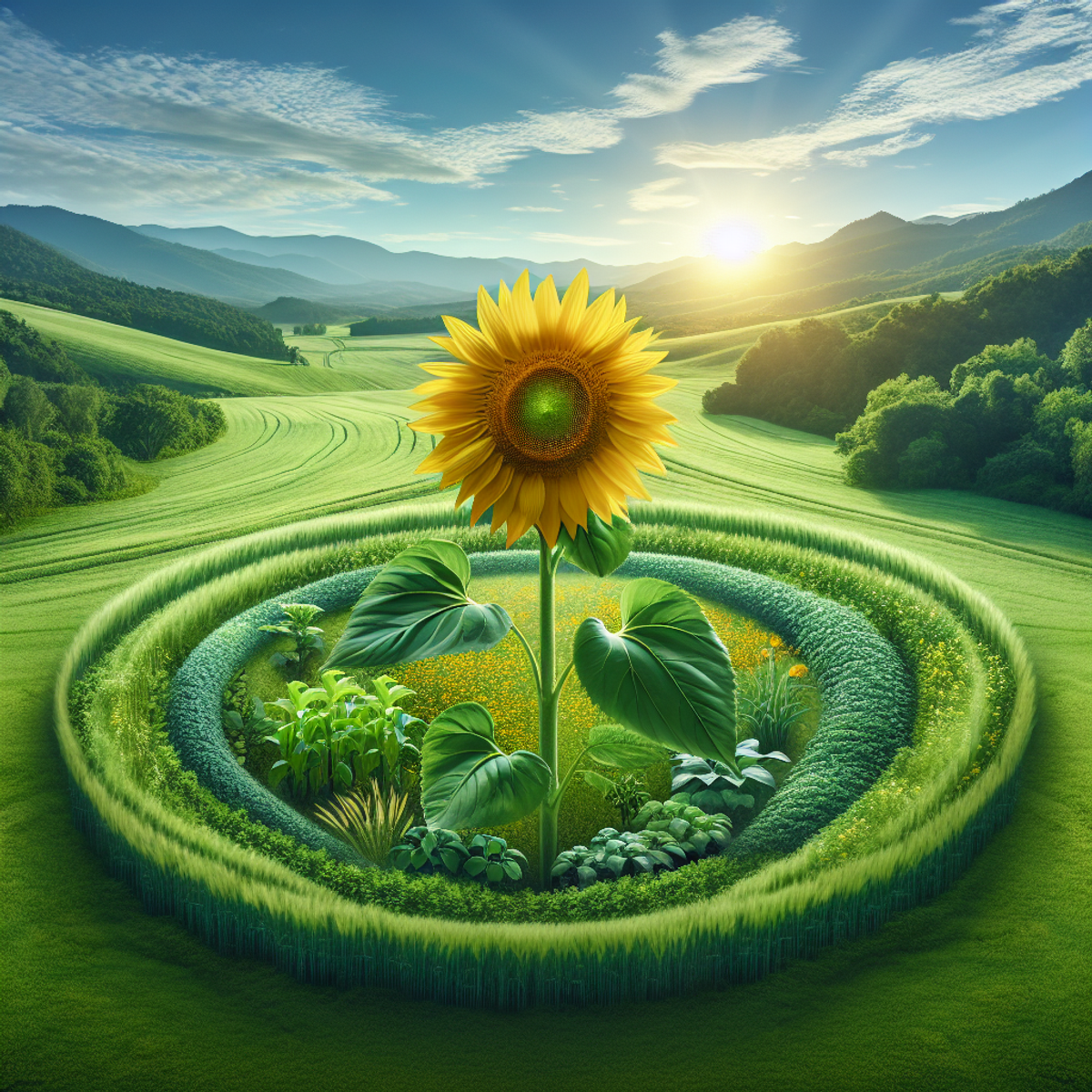Python for Sustainable Food Systems
Python for Sustainable Food Systems
Introduction
Sustainable food systems are essential for addressing the complex challenges of global food production and consumption. As the world's population continues to grow, there is an increasing need for innovative and efficient solutions to ensure food security while minimizing environmental impact. This is where Python farming comes into play, offering a promising alternative that aligns with the principles of sustainability in multiple ways.
Python farming, a concept gaining attention in the realm of sustainable agriculture, has the potential to revolutionize food production by leveraging the unique characteristics of pythons. These reptiles offer a range of benefits that address key concerns associated with conventional farming practices:
- Efficient Food Conversion Ratios: Pythons have demonstrated remarkable efficiency in converting feed into meat compared to traditional livestock, making them an attractive option for sustainable food systems.
- Low Environmental Footprint: Python farming practices have shown reduced impacts on land use, water consumption, and greenhouse gas emissions, aligning with the goals of environmentally conscious agriculture.
- Resilience to Changing Conditions: Pythons exhibit adaptability to diverse environmental conditions, making them well-suited for sustainable farming systems that need to withstand fluctuating climates and landscapes.
This innovative approach to food production represents a paradigm shift towards more resource-efficient and environmentally friendly methods. By exploring Python farming as a viable solution, we can address the pressing challenges of global food security while promoting ecological sustainability.
Understanding Sustainable Food Systems
Sustainable food systems are designed to meet the needs of the present without compromising the ability of future generations to meet their own needs. They aim to provide healthy food to support overall well-being while also promoting environmental sustainability, social equity, and economic viability.
Definition and Goals of Sustainable Food Systems
1. Definition
Sustainable food systems encompass the entire process of food production, distribution, consumption, and waste management. They prioritize environmentally friendly practices, animal welfare, and fair treatment of workers.
2. Goals
The primary objectives of sustainable food systems include:
- Reducing greenhouse gas emissions
- Conserving natural resources
- Minimizing waste generation
- Ensuring food security for all
Critical Role in Ensuring Global Food Security
1. Food Security
Sustainable agriculture plays a crucial role in global food security by promoting resilient farming practices that can withstand environmental changes and disruptions. It aims to ensure a reliable and equitable food supply for all individuals.
2. Resilience
By diversifying agricultural methods and reducing reliance on unsustainable practices, sustainable food systems contribute to global resilience against climate change, extreme weather events, and other challenges.
Environmental Challenges Posed by Conventional Farming Practices
1. Resource Depletion
Conventional farming methods often lead to soil degradation, water depletion, and loss of biodiversity due to intensive pesticide and fertilizer use.
2. Climate Impact
The agricultural sector is a significant contributor to greenhouse gas emissions through processes such as livestock digestion, manure management, and deforestation for farming expansion.
Sustainable food systems seek to address these challenges by implementing innovative technologies and nature-based solutions that prioritize long-term ecological balance and resource conservation.
Challenges in Achieving Sustainable Agriculture
Sustainable agriculture faces several challenges that hinder its widespread adoption and implementation. These obstacles range from resource limitations and scalability issues to policy and regulatory barriers. Understanding and addressing these challenges is crucial for advancing sustainable food systems.
Resource Limitations and Scalability Issues
Sustainable agriculture often encounters resource limitations, including access to arable land, water, and capital. Small-scale farmers, in particular, may struggle to compete with larger industrial operations due to limited resources. Additionally, the scalability of sustainable farming practices can be challenging, especially when attempting to transition from conventional farming methods.
Lack of Awareness and Consumer Demand for Sustainable Products
A significant challenge in achieving sustainable agriculture is the lack of awareness and consumer demand for sustainable products. Many consumers may not fully understand the environmental and social impact of their food choices or may prioritize factors such as convenience and cost over sustainability. Educating consumers about the benefits of sustainable agriculture and fostering demand for sustainably produced food is essential for driving change.
Policy and Regulatory Obstacles
Policy and regulatory barriers pose significant challenges to the widespread adoption of sustainable agricultural practices. In some regions, existing policies may favor conventional farming methods or create barriers to entry for sustainable farming initiatives. Additionally, navigating complex regulations related to land use, organic certification, and agricultural subsidies can be daunting for farmers seeking to transition to more sustainable practices.
Addressing these challenges requires a multi-faceted approach that involves collaboration between policymakers, industry stakeholders, and consumers. By identifying solutions to resource limitations, raising awareness about sustainability issues, and advocating for supportive policies, the path toward achieving sustainable agriculture becomes more attainable.
The Potential of Python Farming for Sustainable Food Systems
Python farming is emerging as a sustainable and innovative solution to address the challenges faced by traditional livestock farming practices. With its efficient food conversion ratios and low environmental footprint, python farming holds great promise in contributing to sustainable food systems. In this section, we will delve into the potential of python farming and explore how pythons are able to convert feed into meat more effectively compared to traditional livestock.
Efficient Food Conversion Ratios
One of the key advantages of python farming is its remarkable food conversion ratios. Pythons have the ability to convert feed into meat more efficiently than conventional livestock such as chickens, pigs, or cattle. Research has shown that farm-raised pythons outperform mainstream agricultural species in terms of food and protein conversion ratios.
Unlike traditional livestock that require large quantities of feed to produce a relatively small amount of meat, pythons have a unique physiological makeup that allows them to optimize their energy consumption. They are ectothermic animals, which means they rely on external heat sources to regulate their body temperature. This characteristic enables them to allocate more energy towards growth and reproduction rather than maintaining a constant body temperature.
Additionally, pythons have a slow metabolic rate, which helps them conserve energy and utilize feed more efficiently. They can survive for long periods without eating, allowing them to make the most of their food resources. This efficiency in converting feed into meat makes python farming an attractive option for sustainable food production.
Low Environmental Footprint
Another significant advantage of python farming is its low environmental footprint. Conventional livestock farming practices often contribute to deforestation, water pollution, and greenhouse gas emissions. In contrast, python farming offers a more sustainable alternative with reduced impact on land, water, and emissions.
Land Efficiency
Python farms require significantly less land compared to traditional livestock operations. As pythons do not need large grazing areas like cattle or sheep, they can be farmed in smaller spaces, making efficient use of land resources. This is particularly beneficial in regions where land availability is limited or where the preservation of natural habitats is a priority.
Water Conservation
Moreover, python farming requires little water compared to conventional livestock farming. Water scarcity is a growing concern globally, and agriculture is one of the primary sectors responsible for water consumption. By requiring less water for their growth and survival, pythons help alleviate pressure on freshwater resources.
Reduced Greenhouse Gas Emissions
In terms of greenhouse gas emissions, python farming demonstrates favorable environmental performance. Methane emissions from ruminant animals like cows and sheep significantly contribute to global warming. As pythons are not ruminants and have a slower digestion process, they produce fewer methane emissions. This reduction in greenhouse gas emissions makes python farming a more environmentally sustainable choice for food production.
Resilience to Changing Conditions
Python farming offers resilience to changing environmental conditions, making it suitable for sustainable food systems. Pythons have evolved to thrive in diverse habitats and are well-adapted to different environmental conditions. This adaptability allows them to withstand fluctuations in temperature, humidity, and food availability.
In regions prone to climate change impacts or extreme weather events, traditional livestock farming may face challenges due to the vulnerability of certain species.
Low Environmental Footprint
Python farming is an environmentally-friendly solution to the environmental issues caused by traditional agriculture. It promotes sustainability and can greatly reduce the negative impact of food production on the environment through its efficient use of resources and high productivity.
Here are the key points highlighting the low environmental footprint of Python farming:
- Land Use: One of the significant advantages of Python farming is its minimal land requirements. Compared to traditional livestock systems, pythons can be raised in smaller spaces, which reduces the need for extensive land clearing and deforestation. This not only helps preserve natural habitats but also minimizes soil erosion and degradation.
- Water Efficiency: Water scarcity is a critical concern in many regions around the world. Python farming addresses this challenge by requiring significantly less water compared to traditional livestock farming. Pythons have lower water intake needs, making them more efficient in water usage. This reduced water demand not only conserves this precious resource but also alleviates pressure on local water sources.
- Greenhouse Gas Emissions: The livestock sector is a significant contributor to greenhouse gas emissions, particularly methane and nitrous oxide. However, Python farming has a considerably lower carbon footprint than traditional livestock rearing methods. Pythons produce fewer greenhouse gas emissions due to their unique digestive system, which allows for more efficient food conversion.
- Manure Management: Traditional livestock farming generates large quantities of manure that can contribute to water pollution and emit harmful gases. In contrast, Python farming produces minimal waste due to the pythons' highly efficient food conversion ratios. Furthermore, any waste produced can be repurposed as fertilizer or biofuel feedstock, reducing waste accumulation and creating a closed-loop system.
By minimizing land use, conserving water resources, reducing greenhouse gas emissions, and implementing sustainable waste management practices, Python farming demonstrates its potential as an environmentally friendly alternative to conventional agriculture.
"Python farming offers a sustainable and efficient approach to food production by minimizing land use, conserving water resources, reducing greenhouse gas emissions, and implementing sustainable waste management practices."
Python farming's low environmental footprint not only contributes to the preservation of natural resources but also addresses some of the pressing environmental challenges faced by conventional agriculture. This innovative farming practice offers a promising solution for sustainable food systems.
Resilience to Changing Conditions
Python farming offers a unique and innovative approach towards sustainable agriculture. With its ability to thrive in diverse environmental conditions, pythons have emerged as a resilient alternative for sustainable farming systems. Let's explore how their adaptability makes them a suitable choice in the quest for sustainable food systems.
Adaptability to Diverse Environmental Conditions
One of the key advantages of python farming is the ability of these reptiles to adapt and thrive in various environmental conditions. Unlike traditional livestock that require specific climates or environments, pythons can tolerate a wide range of temperatures and humidity levels. This adaptability makes them suitable for farming in different regions, including areas with challenging climates or limited resources.
Efficient Resource Utilization
Python farming stands out for its efficient utilization of resources, making it an attractive option for sustainable food systems. These reptiles have an impressive food conversion ratio, meaning they can convert feed into meat more effectively compared to traditional livestock. Studies have shown that pythons outperform mainstream agricultural species when it comes to food and protein conversion ratios. This efficiency translates into less feed required per unit of meat produced, reducing resource consumption and waste.
High Productivity
In addition to their efficient resource utilization, pythons also exhibit high productivity levels, further contributing to their suitability for sustainable farming systems. These reptiles have the potential for rapid growth rates and can reach marketable sizes within a relatively short period. This means that python farming can yield a higher output of meat compared to traditional livestock systems in the same timeframe. The combination of efficient resource utilization and high productivity makes python farming an attractive option for meeting the growing demand for sustainable protein sources.
Climate Change Resilience
As climate change continues to pose challenges to global agriculture, finding resilient solutions becomes crucial. Python farming demonstrates resilience in the face of changing climatic conditions. These reptiles have evolved over millions of years to survive in diverse environments, including regions with fluctuating temperatures and varying rainfall patterns. By harnessing the adaptability of pythons, sustainable food systems can better withstand the impacts of climate change, ensuring a more reliable and consistent food supply.
Biodiversity Conservation
In addition to their resilience to changing conditions, python farming also presents opportunities for biodiversity conservation. By focusing on farming pythons instead of traditional livestock species, we can alleviate the pressure on natural ecosystems caused by conventional agricultural practices. Python farming requires less land and water compared to livestock farming, reducing habitat destruction and freshwater consumption. This approach supports the preservation of natural habitats and helps protect biodiversity in vulnerable areas.
Promoting Sustainable Food Systems
Python farming aligns with the principles of sustainability by offering efficient resource utilization, high productivity, and resilience to changing conditions. By embracing innovative approaches like python farming, we can move towards more sustainable and resilient food systems. However, it is essential to approach python farming with caution and conduct further research to address any potential ethical concerns.
Mitigating Disease Risks in Python Farming
Python farming is not only a solution for sustainable agriculture in terms of resource utilization and productivity but also brings advantages in disease management. Farmed pythons have shown natural resilience to diseases and parasites, reducing the need for antibiotics and veterinary interventions. Here are some key points to consider:
1. Natural Resilience
Pythons have evolved over time to withstand various diseases and parasites that commonly affect other livestock species. Their robust immune systems allow them to resist infections and recover quickly from illnesses. This natural resilience is a valuable asset for python farming as it reduces the reliance on antibiotics and other medical interventions.
2. Reduced Antibiotic Use
Antibiotics are commonly used in conventional livestock farming to prevent and treat diseases. However, overuse and misuse of antibiotics contribute to the development of antibiotic-resistant bacteria, posing a significant threat to public health. Python farming offers an alternative approach by minimizing the use of antibiotics due to the pythons' inherent resistance to diseases.
3. Parasite Control
Parasites can cause significant harm to livestock, leading to reduced growth rates, decreased productivity, and increased mortality. Unlike traditional livestock species, pythons have a lower susceptibility to common parasites found in agricultural settings. This natural resistance reduces the need for parasitic treatments, further contributing to sustainable farming practices.
4. Disease Prevention
In addition to their natural resilience, python farming can also benefit from disease prevention strategies. Implementing strict biosecurity measures helps minimize the risk of introducing pathogens into python farms. This includes controlling access by people and animals, practicing proper waste management, and ensuring hygienic conditions within the farm environment.
5. Research and Monitoring
Ongoing research is essential for understanding potential disease risks associated with python farming and developing effective management strategies. Regular monitoring of individual pythons and their overall health status allows early detection of any potential diseases or outbreaks. This proactive approach enables prompt intervention and prevents the spread of infections within the farm.
Python farming's ability to mitigate disease risks aligns with the principles of sustainable agriculture by reducing the use of antibiotics, minimizing environmental contamination, and promoting animal welfare. By harnessing the natural resilience of pythons, farmers can maintain healthier livestock populations while minimizing the impact on human health and the environment.
However, it is important to note that although python farming shows promise in disease management, ongoing research and monitoring are crucial to ensure its long-term sustainability. As with any agricultural practice, there may be specific disease challenges or emerging pathogens that need to be addressed. By staying vigilant, continuously improving farming practices, and adapting to new information, python farmers can maintain a healthy and resilient farming system.
Addressing Nutritional Concerns and Consumer Acceptance
Python farming has gained attention as a solution for sustainable food systems, thanks to its efficient food conversion ratios and low environmental impact. However, the acceptance of python meat among consumers, particularly in Western cultures, presents certain challenges. In this section, we will explore the nutritional value of python meat and potential strategies to promote its acceptance among consumers.
Exploring the Nutritional Value of Python Meat
Python meat offers several nutritional benefits that make it an attractive alternative to traditional livestock products. Here are some key points to consider:
- Protein Content: Python meat is rich in protein, which is essential for muscle growth and repair. It contains all the essential amino acids required by the human body.
- Low Fat: Python meat is relatively low in fat compared to other meats such as beef or pork. This makes it a healthier choice for individuals who are conscious of their fat intake.
- Vitamins and Minerals: Python meat is a good source of vitamins and minerals, including vitamin B6, vitamin C, iron, and zinc. These nutrients play crucial roles in maintaining overall health and supporting various bodily functions.
- Sustainable Production: Python farming requires fewer resources and has a lower environmental impact compared to traditional livestock farming. By choosing python meat, consumers can contribute to more sustainable food systems.
Strategies for Promoting Consumer Acceptance
While python meat offers nutritional benefits, consumer acceptance remains a challenge due to cultural factors and unfamiliarity with this protein source. Here are some strategies to promote consumer acceptance:
- Education and Awareness: Providing accurate information about python farming practices and the nutritional benefits of python meat is essential. Educational campaigns can help dispel myths or misconceptions surrounding python farming while highlighting its sustainability advantages.
- Culinary Innovation: Introducing python meat into local cuisines can be an effective way to familiarize consumers with this protein source. Chefs and food enthusiasts can experiment with recipes that showcase the unique flavor and texture of python meat, making it more appealing to a wider audience.
- Collaboration with Retailers: Partnering with retailers and supermarkets can help increase the availability of python meat products. By making python meat easily accessible, consumers will have the opportunity to try it and incorporate it into their regular diet.
- Marketing and Branding: Developing a positive brand image for python farming and its associated products can create consumer trust and interest. Highlighting the sustainable aspects of python farming, such as its low environmental impact, can resonate with environmentally conscious consumers.
- Nutritional Labeling: Transparent and informative labeling on python meat products can help consumers make informed choices about their food purchases. Including nutritional information on packaging can educate consumers about the nutritional value of python meat and its place in a balanced diet.
By implementing these strategies, we can raise awareness about python farming, address nutritional concerns, and promote consumer acceptance of python meat as a sustainable and nutritious food source.
In conclusion, addressing nutritional concerns and promoting consumer acceptance are crucial steps in integrating python farming into sustainable food
The Future of Python Farming: Opportunities and Considerations
Python farming has shown great potential as a sustainable and resilient form of agricultural food production. As we look to the future, there are several opportunities and considerations that need to be taken into account to ensure the success and scalability of Python farming practices.
Current Status and Future Potential of Python Farming Practices
Currently, Python farming is still in its early stages of development. However, research and pilot projects have demonstrated the viability of this farming method. As more studies are conducted and knowledge about Python farming expands, we can expect to see advancements in various areas:
1. Improved husbandry practices
With further research and experience, farmers will gain a deeper understanding of the specific care requirements for pythons. This will lead to the development of more effective and efficient husbandry practices, resulting in improved python health and welfare.
2. Technological advancements
As technology continues to advance, we can expect to see innovations that enhance Python farming. This may include automated feeding systems, environmental control systems, and monitoring tools that optimize python growth while minimizing resource consumption.
3. Increased awareness and support
As the benefits of Python farming become more widely known, we can anticipate an increase in awareness and support from consumers, policymakers, and investors. This support will help drive further research, investment, and the establishment of regulatory frameworks that facilitate the growth of Python farming.
Key Considerations for Scaling Up Python Farming Operations
While there is significant potential for Python farming, it is crucial to consider certain factors when scaling up operations to ensure long-term sustainability:
1. Ecological balance
As Python farming expands, it is important to maintain ecological balance within local ecosystems. This involves carefully managing python populations to prevent negative impacts on native wildlife populations or biodiversity. Implementing responsible breeding programs and monitoring population sizes will be essential in achieving this balance.
2. Animal welfare standards
The ethical treatment of animals should always be a priority in farming systems. As Python farming grows, it will be essential to establish and adhere to robust animal welfare standards. This includes providing adequate space, appropriate nutrition, and veterinary care for pythons throughout their lifecycle.
3. Resource management
Python farming should be mindful of resource limitations and aim for efficient resource utilization. This includes optimizing feed conversion ratios, minimizing water usage, and reducing energy consumption. Implementing sustainable farming practices, such as utilizing waste meat as python feed, can contribute to resource efficiency.
4. Market demand and consumer acceptance
The success of Python farming will depend on consumer acceptance and demand for python meat and products. Strategies should be developed to educate consumers about the nutritional value and sustainability benefits of python meat. Engaging with local communities, partnering with chefs or restaurants, and promoting python meat through various marketing channels can help create awareness and build consumer acceptance.
Embracing a Sustainable and Resilient Future
Python farming holds immense promise as a sustainable solution for future food production. By leveraging the unique characteristics of pythons, we can address the challenges posed by conventional livestock systems while ensuring environmental sustainability and food security.
As we move forward, it is important to approach Python farming with caution, conducting further research, addressing potential ethical concerns, and continuously evaluating its impact on ecosystems and animal welfare. Embracing technology-driven solutions like Python farming alongside other sustainable agricultural practices will play a vital role in shaping a more resilient future for our food systems.
By supporting sustainable food systems through our choices as consumers or aspiring farmers, we can contribute to the transformation of the agricultural industry towards a more sustainable and resilient model that prioritizes environmental stewardship, animal welfare, and global food security.
Python farming offers a glimpse into what is possible when we embrace innovative approaches to agriculture. Let us continue exploring new frontiers in sustainable food production to create a better future for all.
Conclusion
As we work towards creating sustainable food systems, it's crucial to explore innovative solutions that are in line with sustainability principles. Python farming has emerged as a promising approach that offers:
- Efficient food conversion ratios
- Low environmental impact
- Resilience to changing conditions
In this final section, let's summarize the key points discussed and reflect on the role of Python farming in shaping a more sustainable and resilient future for agriculture.
Supporting Sustainable Food Systems
As consumers or aspiring farmers, we have the power to support sustainable food systems through our choices. By opting for sustainable and ethically produced food, such as python meat, we can contribute to reducing the negative environmental impacts of conventional farming practices. Here are some ways we can make a difference:
- Prioritize local and organic options whenever possible.
- Seek out information about the origin and production methods of our food.
Approaching Python Farming with Caution
While Python farming shows promise, it is important to approach it with caution. Further research is needed to fully understand all aspects of python farming, including its impact on ecosystems and biodiversity. Additionally, addressing ethical concerns related to animal welfare and ensuring responsible farming practices should be a priority.
The Role of Technology in Sustainability
Python farming exemplifies how technology can play a crucial role in shaping a sustainable future for agriculture. By leveraging technological advancements such as controlled environment systems and precision feeding techniques, python farming demonstrates how innovation can contribute to efficient resource utilization while minimizing environmental impact.
"Sustainable agriculture is not just about preserving our planet; it is also about nourishing our bodies and communities." - Unknown
In conclusion, Python farming holds great potential for sustainable food systems. It offers efficient food conversion ratios, has a low environmental footprint, and showcases resilience to changing conditions. However, it is essential to be mindful of ethical considerations and conduct further research to ensure that python farming aligns with sustainable practices.
By supporting sustainable food systems through our choices as consumers or aspiring farmers, we can contribute to a more resilient and environmentally friendly future. Let us embrace technology, such as Python farming, as a tool to shape the way we produce and consume food. Together, we can create a world where sustainability and nourishment go hand in hand.
"The choices we make about the food we eat have a direct impact on the health of our planet." - Jonathan Safran Foer
FAQs (Frequently Asked Questions)
What are the key principles of sustainable food systems?
Sustainable food systems are based on efficient food conversion ratios, low environmental footprint, and resilience to changing conditions. These principles aim to address global food security and environmental impact while promoting sustainable agriculture.
What are the main challenges in achieving sustainable agriculture?
The challenges include resource limitations, scalability issues, lack of awareness and consumer demand for sustainable products, as well as policy and regulatory obstacles.
How do pythons achieve efficient food conversion ratios in farming?
Pythons are able to convert feed into meat more effectively compared to traditional livestock, making them a promising solution for sustainable food systems.
What is the environmental footprint of Python farming?
Python farming has a reduced impact on land, water, and greenhouse gas emissions, aligning with the goals of sustainable agriculture.
How do pythons demonstrate resilience to changing conditions in farming?
Pythons have the ability to thrive in diverse environmental conditions, making them suitable for sustainable farming systems that need to adapt to changing circumstances.
How does Python farming mitigate disease risks?
Farmed pythons naturally demonstrate resilience to diseases and parasites, reducing the need for antibiotics and veterinary interventions in farming practices.
What are some strategies for addressing nutritional concerns and consumer acceptance of python meat?
Exploring the nutritional value of python meat and potential strategies to promote its acceptance among consumers, particularly in Western cultures, is crucial for the success of Python farming as a sustainable food system.



Comments
Post a Comment